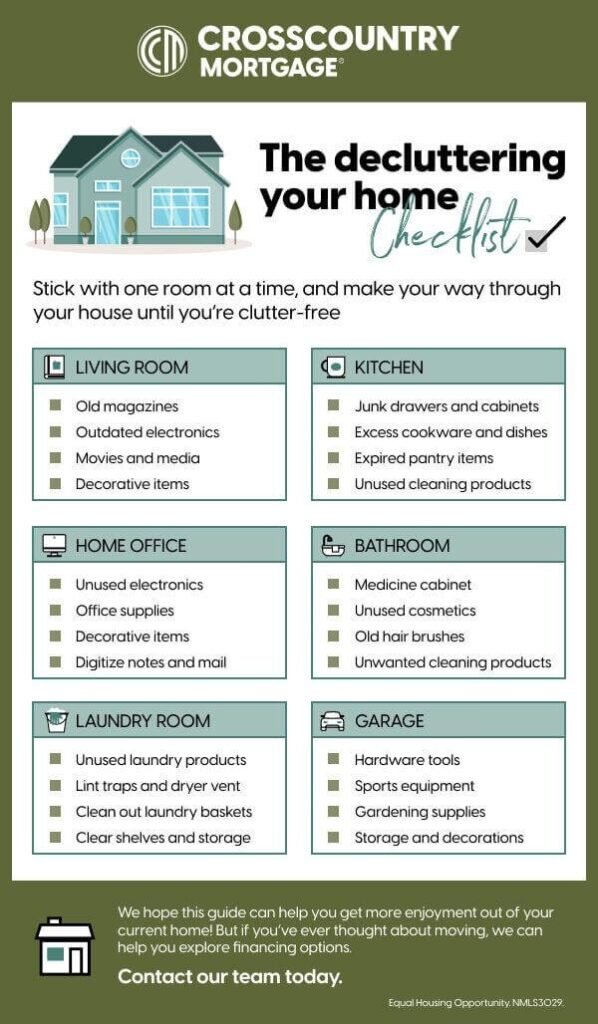
Decluttering can be an extensive endeavour. To stay motivated and keep the momentum going, break it into smaller tasks to prevent becoming overwhelmed and overwhelmed.
Marie Kondo has gained worldwide renown as the go-to expert on decluttering. Through her book and Netflix show Tidying Up, she advocates going room by room through items, asking if they spark joy before discarding those that don’t bring satisfaction.
Room 1: Living Room
An unorganized living room can negatively impact any household, and it is especially detrimental when entertaining guests or watching TV in private. Your space should provide comfort and convenience.
The first step to decluttering a living room is to remove items that don’t belong here—such as toys for young ones who should remain in their rooms, mail or magazines that belong elsewhere in your office, glasses or dishware that belong in the kitchen, and so forth.
Take the time to assess every item being removed from your living room and decide the best course of action for each one, such as clothes or books you may find unfamiliar or unexamined. Donate them instead of throwing them out – this will reduce waste while contributing to a more eco-conscious lifestyle.
Decluttering can take time and effort, but its rewards are immense. Set a regular maintenance schedule so your living spaces remain clutter-free; ideally this should be done weekly so any clutter is removed quickly rather than building up over time.
Room 2: Bedroom
Decluttering a bedroom can be challenging due to small items that accumulate quickly—watches, jewellery, hair bands, and chapsticks among them—so starting small—such as on top of dressers or nightstands—will give you the confidence to tackle more daunting projects like your closet.
As you move around the room, ask yourself whether each item serves a useful purpose or should remain. Additionally, it’s helpful to remove everything from the space to see how it looks without anything in it, making the Three-Box Method more helpful than traditional sorting systems.
Finally, when returning items to their rooms, keep flat surfaces as straightforward as possible, creating an airier and calmer feeling. It’s also wise to get into the habit of clearing these spaces out on an ongoing basis so clutter does not build back up again; for example, when switching seasons, you can swap out winter clothing with summer ones and store away what doesn’t belong anymore.
Room 3: Bathroom
Decluttering is more than simply cleaning out. It involves taking an intentional and strategic approach to reviewing and organizing what you own so that your home remains tidy, functional, and stress-free.
Clutter is not only unsightly but can also be hazardous if stored near heating sources. According to the United States Fire Administration, clutter-filled spaces may block escape routes and interfere with firefighting firefighting firefighting efforts, leading to injuries and property loss.
Bathroom clutter tends to build quickly in households with multiple family members who each bathe at different times, leading to piles of toilet paper, medicine, and household products being stored there, along with makeup products, clothing items, and towels used by each member.
Decluttering a bathroom can be difficult, so take small steps and evaluate each item, especially those likely to be valuable or sentimental. Also, set up a maintenance schedule so the clutter does not return; for instance, try clearing out one drawer or cabinet every two weeks or every month until decluttering has been completed.
Room 4: Kitchen
An overly cluttered kitchen can make cooking and meal preparation challenging and pose fire risks when items are stored too close to heat sources. Learning how to declutter your kitchen will keep it safe and functional for cooking, cleaning, entertaining, and more.
Decluttering makes it easier to locate items you need, which can increase home productivity, save time and money, reduce stress levels, and provide peace of mind. Furthermore, decluttering can help focus on important projects while offering guests a pleasant atmosphere free of clutter.
Maintaining a clutter-free kitchen begins with regular cleanings and being selective in what items enter. Consider adopting the KonMari method, whereby only items that bring you joy should remain. This will keep the space organized and prevent future accumulation.
Clutter has many adverse impacts on life and well-being, which makes decluttering an essential task for good living. Learning to prevent clutter from building up in the first place may also prove helpful so that decluttering will become less daunting in the future.
Room 5: Dining Room
Decluttering requires searching drawers, closets, and cupboards for long-forgotten treasures that have accumulated over time. While this can be emotionally taxing, decluttering is essential in creating a clean and safe space. Clutter can prevent residents from leaving in case of fire while impeding firefighting efforts.
Establish a timeline and choose an approach for decluttering that works best for you, setting an appropriate timetable and selecting an effective cleanup method. Delaying decluttering projects too long often causes more clutter to accumulate over time; try scheduling decluttering projects weekly until your goal has been accomplished.
If you need to declutter in a rush, try the FAST method. Decluttering is particularly suitable for people hosting guests or listing their homes for sale over three days of decluttering items into trash, recycling, and donating categories before cleaning and reorganizing what remains on a final day. This creates a clutter-free environment that reduces stress while improving efficiency, mood, productivity, and safety.
Room 6: Office
Clutter can have detrimental effects on both your home and mental state, particularly if you suffer from anxiety. Decluttering creates an atmosphere of order and calm in your home environment, which can help make you feel more capable and relaxed.
DeclutterinDeclutteringnting, so take it one step at a time and work your way up gradually. Take breaks as needed so as not to burn out or become discouraged; also remember that declutterindecluttering be seen as a race; the goal should be a tidy home, not quick declutterindeclutteringAs part of your cleaning routine, you must categorize items as you go through them. This allows you to track better what items belong, such as office supplies versus everyday household items versus children’s toys from books and movies. Grouping like things also makes finding what you need easier when the time comes.
Once you’ve completed the decluttering, set a regular maintenance schedule to prevent it from returning. Aim for at least 10 minutes daily dedicated to decluttering or a profound sweep twice or thrice annually.
Room 7: Family Room
Family rooms and living areas exist primarily to help us relax, but finding it hard to unwind when the space is filled with toys, electronics, cables, and blankets can make decluttering a task that should take less than half the time you think it would. Decluttering your room should be simple if you follow these simple tips.
First, clear all flat surfaces—floors, tables, and countertops—to get an accurate view of what remains. The next step should be sorting and placing away remaining items efficiently to avoid making another mess later on. It is also important to consider other uses for them instead of throwing them away; donate to charity or use them in another way that benefits your family.
Once the clutter has been eliminated from your home, you’ll appreciate the advantages of an organized and clean living environment. Clutter increases stress levels and causes us to misplace essential things; follow these easy tips for decluttering. Begin your journey and have a cleaner and more relaxing home in no time!




